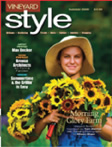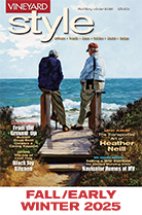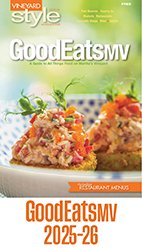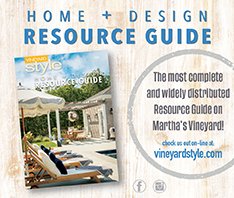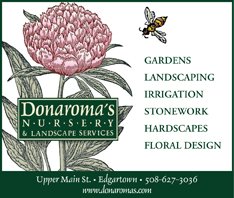GARDENSCAPES
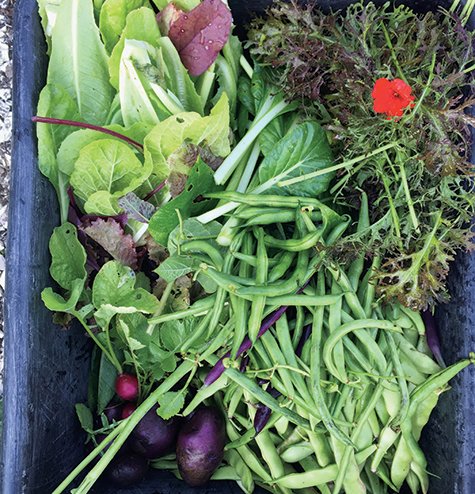
Consider the Blueberry
Rethinking Our Landscape Needs
By Tara Gayle
Are you the guy who bought up all the seeds at the local grain store? Are you the gal who bought pounds of flour “to make bread?” Maybe you’ve realized that your bucolic sensibilities could stream to fruition with beginning construction on the homestead you’ve always dreamed of. Perhaps you’ve commissioned someone to build ten raised beds overnight with no idea of what to put in them. Instead of panic planting, and fearing for the worst, it may be helpful to realize that the resources for abundance are all around us, and this garden could’ve been sown all along. It still can be. I’m with you.
I wish we didn’t need a global pandemic to open our eyes to the importance of food sovereignty, but here we are, so let’s lean in. Each one of us has an inherent right to fresh, affordable, nutritious food. As a naturally abundant island, we have the ability to gain some autonomy from the global food supply chains that limit us from growing our nutrition right in our own backyard.Yet we head to the store to buy heaps of spinach packed into plastic containers, avocados from Mexico, and almonds from the severely dehydrated fields of California. I am absolutely guilty of all of those aforementioned abuses of privilege.
Having some time during quarantine I was able to take a look at what I was buying that I thought would sustain me over the dark days ahead, as we were sure to be confronted with some zombie apocalypse, or whatever gory outcome clocks with the dystopian scenario with which we’re now facing. I got mad. I got motivated. I amplified all of my frustration over the messages I’ve been trying to spew to friends, family and clients about the importance of regenerating our land, and planting for resilient landscapes. I wrote to every local publication in a panic about our need to broadcast this credo (this one actually took me up on it), and then I collapsed into an armchair, until I mustered the strength after several days of debating it, to in fact, bake that damn loaf of bread. I’m lucky. I happen to work in a field that has impassioned me to learn about how to respect my surroundings, which includes the land I live on. Each week is another clue as to what the soil might need. Each season is another push of new growth and abundance from the previous years’ planting of bare root miscellany, discarded from the “weeds” of another’s garden, along with various trees and shrubs, carefully selected for their ecological function.
Unless we’re talking about the rose I’ve tried to train up and over my front door for the past two years for that quaint cottage aesthetic.That thing always dies. The rose has since been replaced with an edible, flowering quince.
Somewhere in March, deep within my bread haze, I decided to get going on my annual seed starting, from the collections I’ve kept over the years. I pulled out my planters and filled them with potting soil, planting early season seedlings I knew would thrive in the colder temperatures like spinach, radish, and beets, setting them in the gallery windows of the once art studio attached to my house. I thought about Spring, and the rebirth of sleeping giant root systems. I thought about how incredible it could be if we–as an island–could course correct and move toward independence through edible, ecological design.
It was somewhere between my eighth or ninth loaf of homemade banana bread when I decided to put my money where my mouth is and get to work on building a homestead here on the mossy, sandy-clay that is lovingly referred to as Mold Manor. I never had the time to focus on my own garden by virtue of being a businesswoman and spending every waking hour in the gardens of others. This was my chance to invest in the future of my time here, to take care of myself, and honor the value for my community and the native landscape I live in. I want to use this time to become a living example of what is possible. After all, time goes by anyway.
I looked at the land. I thought of the blackberry roots I jammed in the ground at the end of last year, and where my new patch of yellow raspberries should go. I built my own raised beds considering the sun angles at the height of the growing season, and filled them with soil that I engineer on my property, composted from seasonal debris. I planted oil seed radish to alleviate inspected every leaf on each one of my fruit trees, and the lush comfrey emerging next to them. Soon this bed would be full with companion plants that would aid in the benefit of each other's proliferation.
I considered the blueberry and the gooseberry. The quince next to my front door. I thought of how beautiful they’ll look when the tall grasses emerge and tuck them into place.The allium between them is a source of food as well as a pest deterrent along with the early show of daffodils.The asters are an insectary and attract pollinators while the thyme runs along the soil as a groundcover.The list goes on.This integration of plants is called a guild.A guild is an intentional polyculture (collection of plants) that are just fine planted alone, but thrive when planted together.
Consider the value of regenerative design like I have. If done correctly, it is a sustained consistent engagement between the steward and the land. It’s a philosophy. It is starting to become a buzzword, but it’s also a practice that is gaining popularity with the modern designer.And yet, there are ways in which it can be easily misconstrued. For instance, no-till farming is wonderful but it doesn’t necessarily equate to regenerative practices if it isn’t being implemented properly.The use of soil labeled as compost without the proper biology isn’t going to help your regenerative efforts but rather cause further issues with opportunistic pathogens. It is a process that is meant to evolve over time. It basically means good farming. Good ecologically focused land management. Patient and proven methods of
turning dead dirt into living soil.No chemicals. No bullshit.Good systems with the same principles share common practice. The best part is, anyone can do it, and we can start right now.
There has never been a better time to understand the importance of building resilient and regenerative landscapes.These environments can and should be designed and encouraged on every inch of this island, and in my opinion, as soon as possible. It’s time that we as a local community, as well as our summer community, reach out to one another to take the reins on what is achievable as we look toward the enrichment and protection of our island’s finite resources. We can feed the future by honoring the present.This can start with food sovereignty.
Food sovereignty is the right to healthy food, produced through ecologically sound and sustainable methods. It is a right to our own food and agriculture systems. We can turn our backyards into food forests, and swaths of acreage into orchards.We can start community gardens with thoughtful design.We can take parks that sit barren and fallow and transform them into lush environments where people can enjoy them year round.Yes, there is the added bonus and benefit of sequestering carbon and improving our soil through thoughtful cultivation of the land around us. Yes, there is opportunity to restore ancient ecology and habitat.All of these possibilities
are the residual benefits of appreciating the privilege and the miracle of the seed, while forgoing the hydrangea for the blueberry. Now is the time to rethink each of our landscaping needs.And for that, I’m here for and with you.
I wish we didn’t need a global pandemic to open our eyes to the importance of food sovereignty, but here we are, so let’s lean in. Each one of us has an inherent right to fresh, affordable, nutritious food. As a naturally abundant island, we have the ability to gain some autonomy from the global food supply chains that limit us from growing our nutrition right in our own backyard.Yet we head to the store to buy heaps of spinach packed into plastic containers, avocados from Mexico, and almonds from the severely dehydrated fields of California. I am absolutely guilty of all of those aforementioned abuses of privilege.
Having some time during quarantine I was able to take a look at what I was buying that I thought would sustain me over the dark days ahead, as we were sure to be confronted with some zombie apocalypse, or whatever gory outcome clocks with the dystopian scenario with which we’re now facing. I got mad. I got motivated. I amplified all of my frustration over the messages I’ve been trying to spew to friends, family and clients about the importance of regenerating our land, and planting for resilient landscapes. I wrote to every local publication in a panic about our need to broadcast this credo (this one actually took me up on it), and then I collapsed into an armchair, until I mustered the strength after several days of debating it, to in fact, bake that damn loaf of bread. I’m lucky. I happen to work in a field that has impassioned me to learn about how to respect my surroundings, which includes the land I live on. Each week is another clue as to what the soil might need. Each season is another push of new growth and abundance from the previous years’ planting of bare root miscellany, discarded from the “weeds” of another’s garden, along with various trees and shrubs, carefully selected for their ecological function.
Unless we’re talking about the rose I’ve tried to train up and over my front door for the past two years for that quaint cottage aesthetic.That thing always dies. The rose has since been replaced with an edible, flowering quince.
Somewhere in March, deep within my bread haze, I decided to get going on my annual seed starting, from the collections I’ve kept over the years. I pulled out my planters and filled them with potting soil, planting early season seedlings I knew would thrive in the colder temperatures like spinach, radish, and beets, setting them in the gallery windows of the once art studio attached to my house. I thought about Spring, and the rebirth of sleeping giant root systems. I thought about how incredible it could be if we–as an island–could course correct and move toward independence through edible, ecological design.
It was somewhere between my eighth or ninth loaf of homemade banana bread when I decided to put my money where my mouth is and get to work on building a homestead here on the mossy, sandy-clay that is lovingly referred to as Mold Manor. I never had the time to focus on my own garden by virtue of being a businesswoman and spending every waking hour in the gardens of others. This was my chance to invest in the future of my time here, to take care of myself, and honor the value for my community and the native landscape I live in. I want to use this time to become a living example of what is possible. After all, time goes by anyway.
I looked at the land. I thought of the blackberry roots I jammed in the ground at the end of last year, and where my new patch of yellow raspberries should go. I built my own raised beds considering the sun angles at the height of the growing season, and filled them with soil that I engineer on my property, composted from seasonal debris. I planted oil seed radish to alleviate inspected every leaf on each one of my fruit trees, and the lush comfrey emerging next to them. Soon this bed would be full with companion plants that would aid in the benefit of each other's proliferation.
I considered the blueberry and the gooseberry. The quince next to my front door. I thought of how beautiful they’ll look when the tall grasses emerge and tuck them into place.The allium between them is a source of food as well as a pest deterrent along with the early show of daffodils.The asters are an insectary and attract pollinators while the thyme runs along the soil as a groundcover.The list goes on.This integration of plants is called a guild.A guild is an intentional polyculture (collection of plants) that are just fine planted alone, but thrive when planted together.
Consider the value of regenerative design like I have. If done correctly, it is a sustained consistent engagement between the steward and the land. It’s a philosophy. It is starting to become a buzzword, but it’s also a practice that is gaining popularity with the modern designer.And yet, there are ways in which it can be easily misconstrued. For instance, no-till farming is wonderful but it doesn’t necessarily equate to regenerative practices if it isn’t being implemented properly.The use of soil labeled as compost without the proper biology isn’t going to help your regenerative efforts but rather cause further issues with opportunistic pathogens. It is a process that is meant to evolve over time. It basically means good farming. Good ecologically focused land management. Patient and proven methods of
turning dead dirt into living soil.No chemicals. No bullshit.Good systems with the same principles share common practice. The best part is, anyone can do it, and we can start right now.
There has never been a better time to understand the importance of building resilient and regenerative landscapes.These environments can and should be designed and encouraged on every inch of this island, and in my opinion, as soon as possible. It’s time that we as a local community, as well as our summer community, reach out to one another to take the reins on what is achievable as we look toward the enrichment and protection of our island’s finite resources. We can feed the future by honoring the present.This can start with food sovereignty.
Food sovereignty is the right to healthy food, produced through ecologically sound and sustainable methods. It is a right to our own food and agriculture systems. We can turn our backyards into food forests, and swaths of acreage into orchards.We can start community gardens with thoughtful design.We can take parks that sit barren and fallow and transform them into lush environments where people can enjoy them year round.Yes, there is the added bonus and benefit of sequestering carbon and improving our soil through thoughtful cultivation of the land around us. Yes, there is opportunity to restore ancient ecology and habitat.All of these possibilities
are the residual benefits of appreciating the privilege and the miracle of the seed, while forgoing the hydrangea for the blueberry. Now is the time to rethink each of our landscaping needs.And for that, I’m here for and with you.

